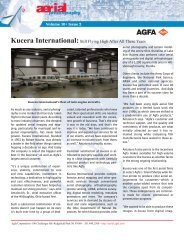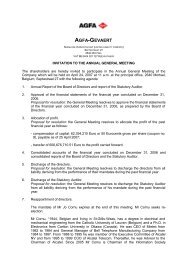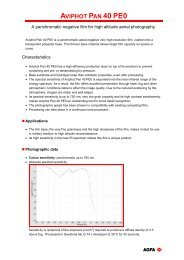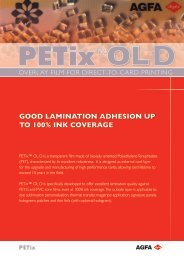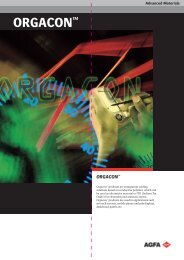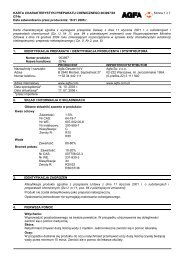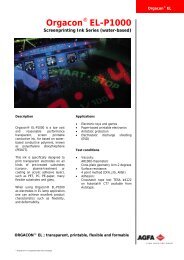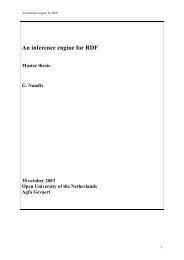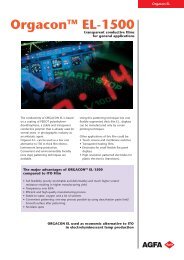Annual Report 2002 - Agfa
Annual Report 2002 - Agfa
Annual Report 2002 - Agfa
Create successful ePaper yourself
Turn your PDF publications into a flip-book with our unique Google optimized e-Paper software.
NOTES TO THE CONSOLIDATED FINANCIAL STATEMENTS<br />
1. Significant accounting policies<br />
continued<br />
(e) Derivative financial instruments<br />
The Group uses derivative financial instruments primarily to manage its exposure to<br />
interest rate and foreign currency risks arising from operational, financing and<br />
investment activities. In accordance with its treasury policy, the Group does not<br />
currently hold or issue derivatives for trading purposes. However, derivatives that<br />
do not qualify for hedge accounting are accounted for as trading instruments.<br />
Derivative financial instruments are recognized initially at cost. Subsequent to<br />
initial recognition, derivative financial instruments are stated at fair value.<br />
Recognition of any resultant gain or loss depends on the nature of the item being<br />
hedged (accounting policy f). Derivative financial instruments that are either<br />
hedging instruments that are not designated or do not qualify as hedges are carried<br />
at fair value with changes in value included in the income statement.<br />
The fair values of derivative interest contracts are estimated by discounting<br />
expected future cash flows using current market interest rates and yield curve over<br />
the remaining term of the instrument. The fair value of forward exchange contracts<br />
is their quoted market price at the balance sheet date, being the present value of the<br />
quoted forward price.<br />
(f) Hedging<br />
Cash flow hedges<br />
Where a derivative financial instrument is designated as a hedge of the variability in<br />
cash flows of a recognized asset or liability, a firm commitment or a highly probable<br />
forecasted transaction, the effective part of any gain or loss on the derivative<br />
financial instrument is recognized directly in equity. When the firm commitment<br />
or forecasted transaction results in the recognition of an asset or liability, the<br />
cumulative gain or loss is removed from equity and included in the initial<br />
measurement of the acquisition cost or other carrying amount of the asset<br />
or liability. Otherwise the cumulative gain or loss is removed from equity and<br />
recognized in the income statement at the same time as the hedged transaction.<br />
The ineffective part of any gain or loss is recognized in the income statement<br />
immediately. Any gain or loss arising from changes in the time value of the<br />
derivative financial instrument is excluded from the measurement of hedge<br />
effectiveness and is recognized in the income statement immediately.<br />
When a hedging instrument or hedge relationship is terminated but the hedged<br />
transaction still is expected to occur, the cumulative gain or loss at that point<br />
remains in equity and is recognized in accordance with the above policy when the<br />
transaction occurs. If the hedged transaction is no longer probable, the cumulative<br />
unrealized gain or loss recognized in equity is recognized in the income statement<br />
immediately.<br />
43<br />
<strong>Agfa</strong> annual report <strong>2002</strong>





